You've bought your yarn and needles, and found the perfect design to make with them. Now what? Before you get started on your project, you need to know how to read knitting patterns!
Knitting patterns can be styled in different ways, but they all generally follow a similar format. While some are mainly text and others have more images, and some may guide you through every step whereas others might leave things for you to figure out, they all have common components.
Once you recognise and understand the standard features of a knitting pattern, you'll be able to follow pretty much any design you can get your hands on!
In our guide on how to read knitting patterns, we'll explain what to look out for and how to get the most out of your pattern. Are you ready? Let's begin…
How to read knitting patterns
A knitting pattern is like a recipe for a finished item – but instead of making a tasty meal, you're creating a pair of socks, or maybe a jumper!
If you follow the recipe exactly, using the same ingredients, you should create something very similar to what the original writer made. But a good pattern will also help you to make little adjustments if you need to.
Just like reading through a recipe before you start baking, it’s a good idea to take the time to read through a pattern before you begin. This will give you an idea of the techniques involved and how you will create the final item.
Similarly, it's always best to look up unfamiliar techniques before you start knitting rather than halfway through a pattern! We have loads of how to knit guides here on Gathered that will help you with everything from beginner skills to expert techniques.
Reading knitting patterns made easy
Just like any other piece of printed text, you'll start reading your knitting pattern at the top left of the page and follow it to the bottom.
But there's a lot more to a pattern than the actual instructions! You'll also find diagrams, charts, tables, lists of materials, and more.
It can be a bit confusing for a beginner, but don't worry – we're about to break down the key elements that appear in our patterns and explain what they all mean.
When you're learning how to read knitting patterns, here are the things you need to look out for:

1. You will need
This section is your shopping list. It tells you exactly what yarn and needles you need to complete the pattern, as well as listing other equipment you may need to source, such as fabric or buttons.
If you use a different yarn to the one stated in the pattern, you'll get different results – and they may not be what you were after! See our guide to yarn substitution to find out how to substitute yarns successfully.
Yarn amounts are based on average requirements, so if your tension is loose, you might need more.
2. Tension
This part of the pattern information panel tells you how to obtain the correct tension required to complete the design by making a square of a specific number of rows and stitches.
Everybody knits differently, and the pattern designer's stitches may be tighter or looser than yours. The tension square measurement is how they communicate this, so you can change needles if necessary to make sure your stitches come out the same.
If your tension square measures smaller than advised, you may need to increase the size of your needles, and vice versa if it’s too large.
It's super important to check your tension before you begin, otherwise your finished item may not be the right size (and no one wants a jumper that doesn't fit over their head!). Read all about knitting tension squares to find out how it's done.
3. Abbreviations
Knitting patterns use abbreviations for brevity and clarity – otherwise patterns would be very long and extremely hard to follow.
While lots of patterns use the same or similar knitting abbreviations, you'll see variations between different designers, so it's always best to check that the terms mean what you think they do before you start knitting.
Take a look at our list of common knitting abbreviations for the ones you're most likely to encounter on Gathered. We also have a knitter's glossary that can help with other knitting terminology.
If a pattern uses special abbreviations or unusual terms that you wouldn't see on a standard abbreviations list, these will also be explained in this section of the pattern.
4. Measurements
Your pattern will state the size of the finished item, either in a measurements section or – if it's a garment – in a table. UK patterns will often feature both centimetres and inches.
In our example, ‘actual’ measurements are the finished size of the item. ‘To fit’ measurements show the recommended measurements of the wearer.
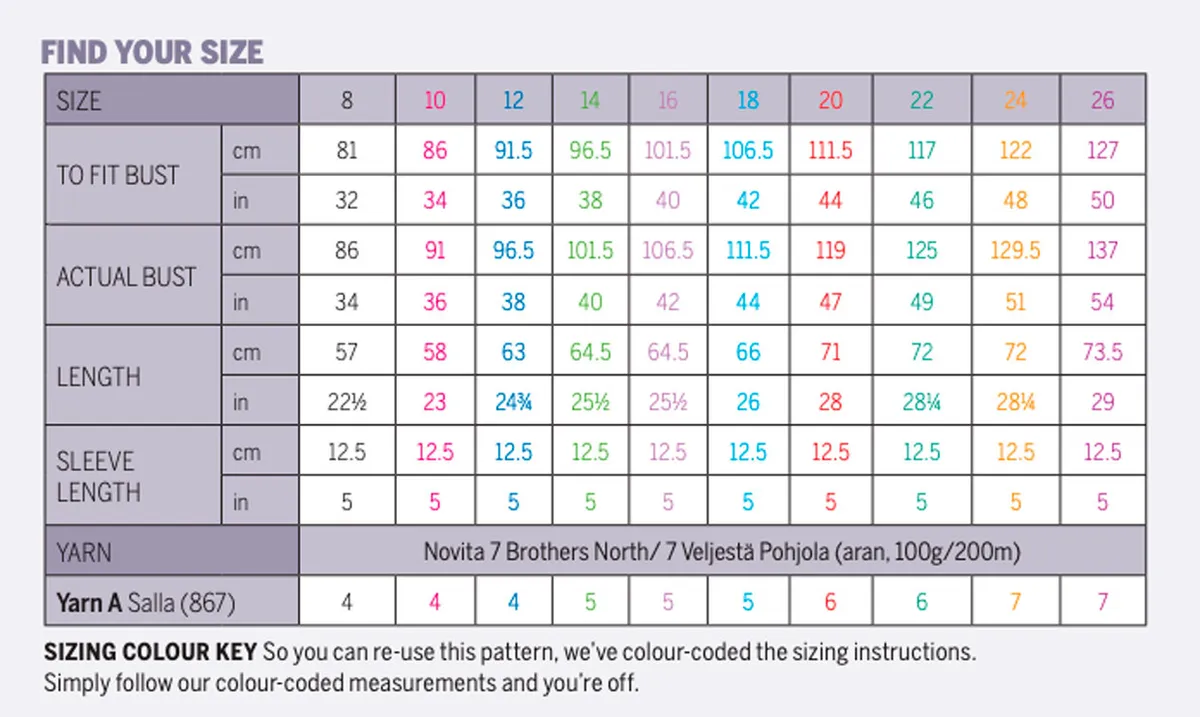
5. Sizing
If the pattern is for a garment or other item that can be made in different sizes, there will usually be a table showing them all.
Some patterns, like the ones in Simply Knitting, use colour-coding to help you follow the instructions for the particular size you need.
If colour-coding isn't used we recommend adding your own with a highlighter, as it makes following the pattern much easier.
Learn the lingo
Discover the language of knitting and make reading patterns easy with our guide to knitting abbreviations.
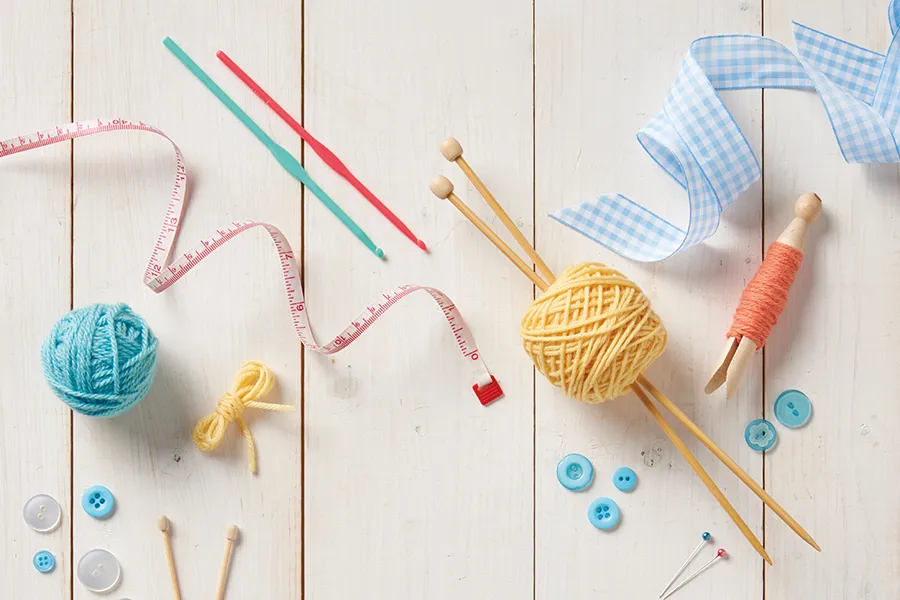
6. How to…
If there’s an element within the pattern that might require a little extra knowledge or skill, there might be a handy how to knit guide, or step-by-step photos, for you to follow.
Some designers will include unusual stitches here, or instructions on a particular increase or decrease that they recommend using.
Take a look at this before you start, and give it a go too! We recommend using scrap yarn to practise your knitting stitches first.
7. Schematic
This is a simple diagram showing you the shape of the pieces you’ll make when creating a garment or other knitted item, as well as their corresponding measurements.
It's a handy visual guide that you can refer back to when sewing up, or when blocking knitting projects and pinning them to the correct size.
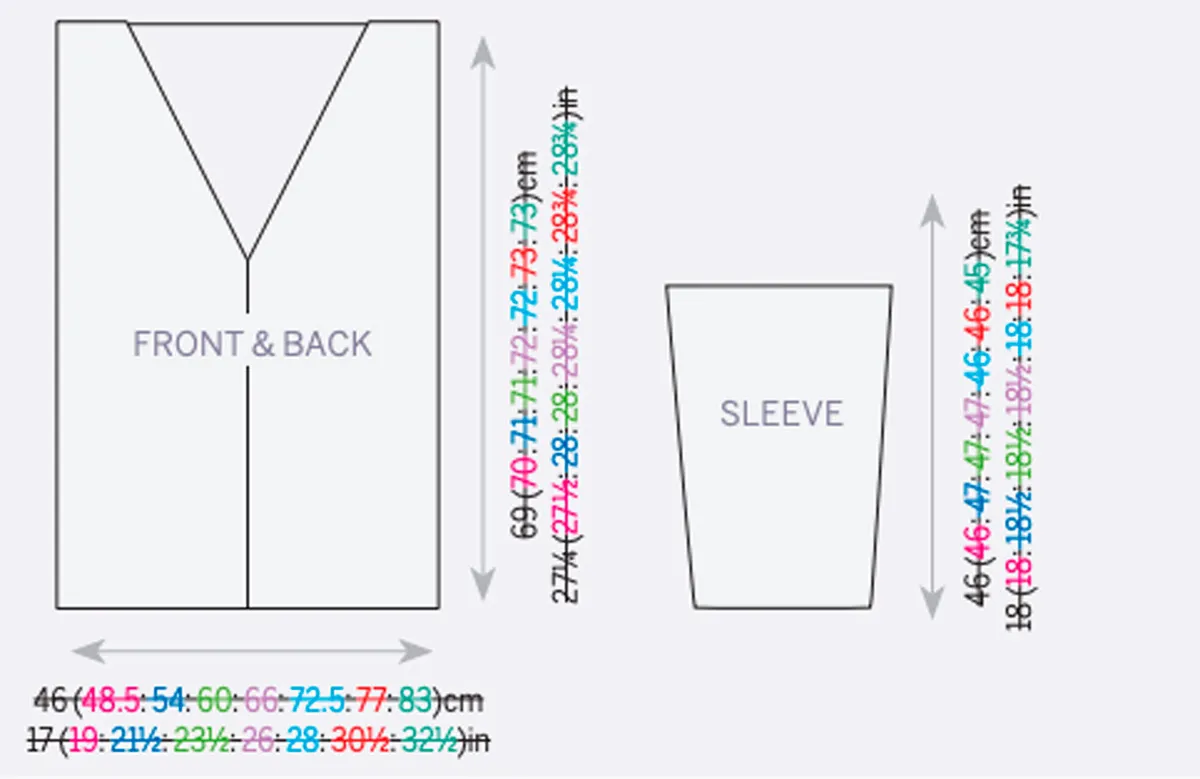
8. Summary
Some patterns include a quick snapshot of the techniques involved, the type of yarn used and the size of needles you need.
That way, you can see at a glance whether it’s a pattern you fancy making.
9. Chart
Often seen on patterns with lace, cables or colourwork, charts are a great visual way to follow a pattern.
They will either sit next to written instructions or be used instead of them. See our guide on how to read charts in knitting patterns to find out how to use them.
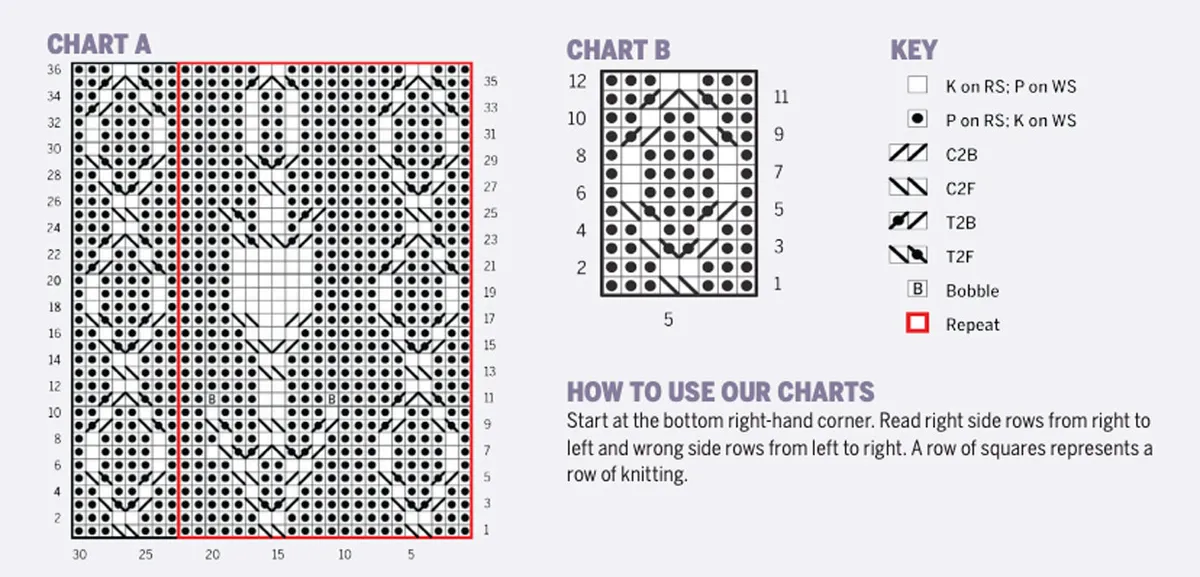
10. Stockists
Many patterns recommend using yarn from a specific manufacturer. In order to help you get that yarn, the pattern will also include stockist details for who to contact about buying the yarn, and retailer information.
We can help you find more places to shop with our guides to the best yarn stores and best British yarns.
How to read knitting pattern charts
Once you know how to read knitting patterns, it's time to learn how to read charts too!
Charts are a handy alternative or accompaniment to written patterns, and are often used to display more complex lace, cable and colourwork designs.
The main thing to remember when following a knitting pattern chart is that each square represents one stitch.
You'll usually start in the bottom right-hand corner of the chart and work up to the top, going from right to left on RS rows and from left to right on WS rows.
To see how this works in practice, and for more tips and advice on following knitting charts, visit our tutorial on how to read charts in knitting patterns. You'll confidently be working from charts in no time!
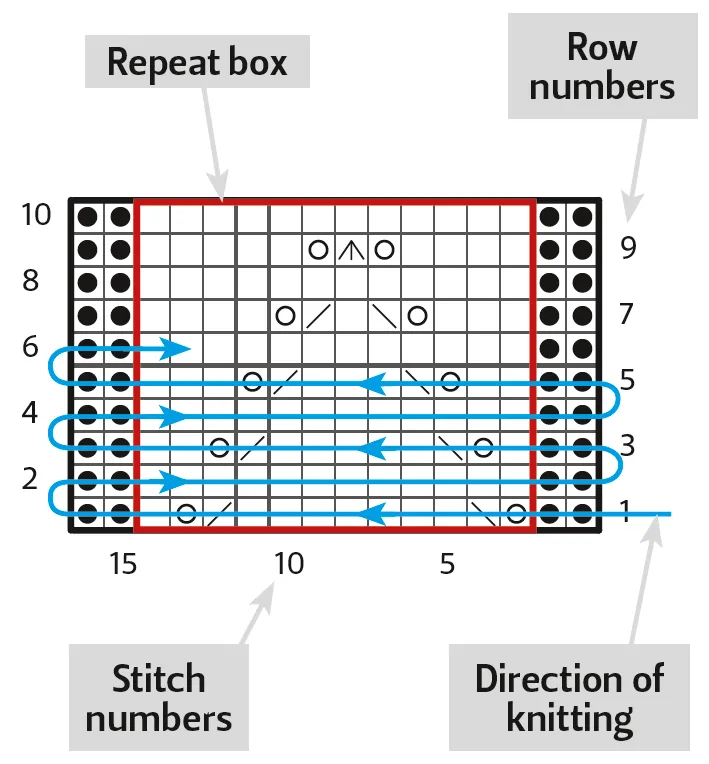
How to read cable knitting patterns
Cable patterns are no more difficult to read than other patterns – once you know how!
You'll notice that cable stitches have their own special abbreviations. When you see the letter C, followed by a number, followed by a letter such as L or R, for example, this is a cable stitch.
They can also be spotted in charts as a diagonal line going through a group of two or more stitches.
In our guide on how to cable knit we explain all about how to read cable knitting patterns, including what the abbreviations mean and why C4F and C4L are the same stitch!
When you're happy with the basics, check out how to read cable charts to learn how to follow even the most complex chart, and fix any mistakes you make along the way.
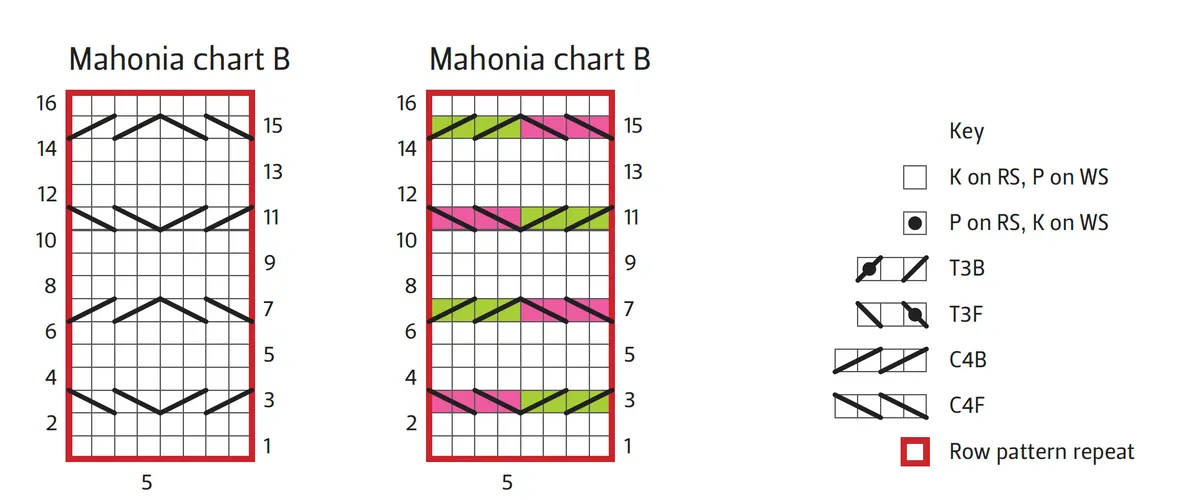
How to read knitting patterns with confidence
There's so much information contained in a knitting pattern that as a beginner it can be hard to know where to start. But the more you prepare before you begin your project, the more likely it is to be successful.
Our list of ten key pattern elements above gives you all the things you need to think about when you're getting ready to cast on. What do you need for the project, what size is it going to be, and are there any special techniques you need to get to grips with?
Always read your pattern thoroughly at the outset, and you won't encounter any surprises later on!
Check your tension with Gathered
You're ready to start following a knitting pattern, but there's something else to do before you cast on: make a tension square.
Learn all about knitting tension squares and why it's important with our expert guide.
